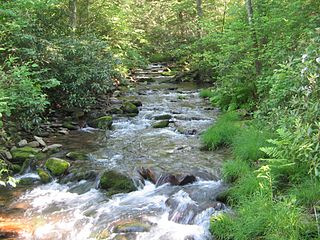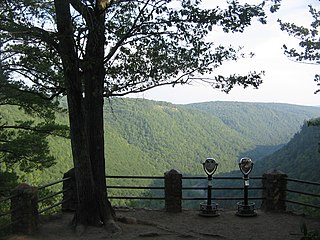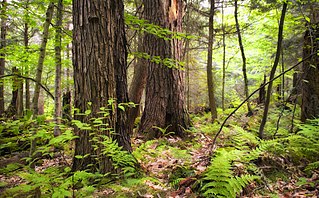
The Shay locomotive was a widely used North-American geared steam locomotive. The locomotives were built to the patents of Ephraim Shay, who has been credited with the popularization of the concept of a geared steam locomotive. Although the design of Ephraim Shay's early locomotives differed from later ones, there is a clear line of development that joins all Shays. Shay locomotives were especially suited to logging, mining and industrial operations and could operate successfully on steep or poor quality track.

The Allegheny National Forest is a National Forest in northwestern Pennsylvania, about 100 miles northeast of Pittsburgh. The forest covers 513,175 acres of land. Within the forest is Kinzua Dam, which impounds the Allegheny River to form Allegheny Reservoir. The administrative headquarters for the Allegheny National Forest is in Warren. The Allegheny National Forest has two ranger stations, one in Marienville, Forest County, and the other in Bradford, McKean County.

Cass Scenic Railroad State Park is a state park and heritage railroad located in Cass, Pocahontas County, West Virginia.

The Yosemite Mountain Sugar Pine Railroad (YMSPRR) is a historic 3 ft narrow gauge railroad with two operating steam train locomotives located near Fish Camp, California, in the Sierra National Forest near the southern entrance to Yosemite National Park. Rudy Stauffer organized the YMSPRR in 1961, utilizing historic railroad track, rolling stock and locomotives to construct a tourist line along the historic route of the Madera Sugar Pine Lumber Company.

Clear Creek State Forest is a Pennsylvania State Forest in Pennsylvania Bureau of Forestry District #8. The main offices are located in Clarion in Clarion County, Pennsylvania in the United States. Until August 2007, it was named Kittanning State Forest.

Tiadaghton State Forest is a Pennsylvania State Forest in the Pennsylvania Department of Conservation and Natural Resources, Bureau of Forestry. The forest is primarily in western and southern Lycoming County, with small portions in Clinton, Potter, Tioga, and Union Counties. The district's topography consists of narrow, flat to sloping plateaus cut by deep, steep-sloped valleys carved by fast moving mountain streams, including Pine Creek, Slate Run, and their tributaries. The Tiadaghton district extends south across the lowland along the west branch of the Susquehanna River to the narrow crests of Bald Eagle Mountain and North and South White Deer Ridge. The majority of forest cover is dominated by mixed oak forests, with some areas of northern hardwoods. The Tiadaghton State Forest is one of eight forest districts in the Pennsylvania Wilds region.

Colton Point State Park is a 368-acre (149 ha) Pennsylvania state park in Tioga County, Pennsylvania, in the United States. It is on the west side of the Pine Creek Gorge, also known as the Grand Canyon of Pennsylvania, which is 800 feet (240 m) deep and nearly 4,000 feet (1,200 m) across at this location. The park extends from the creek in the bottom of the gorge up to the rim and across part of the plateau to the west. Colton Point State Park is known for its views of the Pine Creek Gorge, and offers opportunities for picnicking, hiking, fishing and hunting, whitewater boating, and camping. Colton Point is surrounded by Tioga State Forest and its sister park, Leonard Harrison State Park, on the east rim. The park is on a state forest road in Shippen Township 5 miles (8 km) south of U.S. Route 6.

Leonard Harrison State Park is a 585-acre (237 ha) Pennsylvania state park in Tioga County, Pennsylvania, in the United States. It is on the east rim of the Pine Creek Gorge, also known as the Grand Canyon of Pennsylvania, which is 800 feet (240 m) deep and nearly 4,000 feet (1,200 m) across here. It also serves as headquarters for the adjoining Colton Point State Park, its sister park on the west rim of the gorge. Leonard Harrison State Park is known for its views of the Pine Creek Gorge, and offers hiking, fishing and hunting, whitewater boating, and camping. The park is in Shippen and Delmar Townships, 10 miles (16 km) west of Wellsboro at the western terminus of Pennsylvania Route 660.
The Susquehanna and New York Railroad was a short-line railroad connecting the Lehigh Valley Railroad at Towanda, Pennsylvania, with the Pennsylvania Railroad at Marsh Hill Junction. The railroad carried freight and passengers between Williamsport and Towanda by rail rather than using the Susquehanna River or the Pennsylvania Canal.
The Susquehanna Boom was a system of cribs and chained logs in the West Branch Susquehanna River, designed to catch and hold floating timber until it could be processed at one of the nearly 60 sawmills along the river between Lycoming and Loyalsock Creeks in Lycoming County, Pennsylvania in the United States. The Susquehanna Boom was originally built under the supervision of James H. Perkins, and operated from 1851 to 1909, when it shut down for lack of timber.
The Great Southern Lumber Company was chartered in 1902 to harvest and market the virgin longleaf pine forests in southeastern Louisiana and southwestern Mississippi. Bogalusa, Louisiana was developed from the ground up as a company town and was the location for Great Southern Lumber Company's sawmill, which began operation in 1908. Other company interests included a railroad and paper mill. The company ceased operation in 1938, when the supply of virgin pines was depleted. Bogalusa became the site of a paper mill and chemical operations, followed by other industry.

Hearts Content National Scenic Area is a tract of old-growth forest in Warren County, northwestern Pennsylvania. It represents one of the few remaining old-growth forests in the northeastern United States that contain white pine. The area is protected as a National Scenic Area within the Allegheny National Forest.

A forest railway, forest tram, timber line, logging railway or logging railroad is a mode of railway transport which is used for forestry tasks, primarily the transportation of felled logs to sawmills or railway stations.
The Perry Lumber Company was an early 20th-century company which owned timberland in Perry County, Pennsylvania.

The Buffalo and Susquehanna Railroad was a railroad company that formerly operated in western and north central Pennsylvania and western New York. It was created in 1893 by the merger and consolidation of several smaller logging railroads. It operated independently until 1929, when a majority of its capital stock was purchased by the Baltimore and Ohio Railroad. At the same time, the B&O also purchased control of the neighboring Buffalo, Rochester, and Pittsburgh Railway. The Baltimore and Ohio officially took over operations of both roads in 1932.

The Coudersport and Port Allegany Railroad was a shortline railroad that operated in Potter and McKean Counties in Pennsylvania in the United States between 1882 and 1964. The original line ran 17 miles (27 km) along the Allegheny River between the boroughs of Coudersport, the county seat of Potter County, and Port Allegany in McKean County. The line was originally a 3 ft narrow gauge and converted to 4 ft 8+1⁄2 instandard gauge in 1889. It was prosperous during a lumber boom in the region and expanded east to Ulysses. The lumber boom ended in the early 20th century and the line slowly declined until 1964, when it was purchased by the Wellsville, Addison and Galeton Railroad. The line was finally abandoned in 1970. Today the only surviving building from the railroad is the Coudersport and Port Allegany Railroad Station, which was listed on the National Register of Historic Places in 1976 and serves as the town hall for Coudersport today. As of 2009, much of the C&PA railroad grading can still be found. Railroad bridge abutments exist at Lillibridge Creek in Port Allegany and along the Allegheny River at Coleman Mills, east of Roulette, and east and west of Coudersport.
The East Waterford Lumber Company was an early 20th-century company which leased and harvested timberland in Juniata and Perry County, Pennsylvania.
The Finkbine-Guild Lumber Company was established to harvest and market the virgin longleaf pine stands of southern Mississippi during the early 20th century. The main sawmills were located in Wiggins and D'Lo, Mississippi. When the local timber supply dwindled, the company tried to utilize redwood trees from California, but that operation failed because of high transportation costs. Other attempts were made at promoting a more diversified use of the cutover timberlands; some ventures were successful while others were not.

Pine Creek Gorge, sometimes called The Grand Canyon of Pennsylvania, is a 47-mile (76 km) gorge carved into the Allegheny Plateau by Pine Creek in north-central Pennsylvania.
The Hume-Bennett Lumber Company was a logging operation located in the Sequoia National Forest. It was founded in the early 1900s to store and transport logs. The company closed in 1924 and was purchased by the federal government in 1935.












